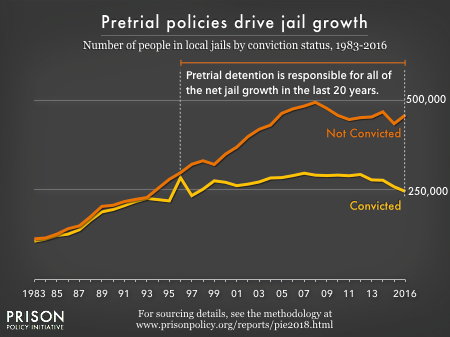New report, Does our county really need a bigger jail?, helps counties avoid needless jail growth
All too often, proposals to expand local jails receive no pushback or critical attention. A new report helps counties think twice.
May 6, 2019
Easthampton, Mass. – A new Prison Policy Initiative report gives cities and counties a long-needed tool for fighting mass incarceration: a guide to preventing unnecessary jail expansion. The report, Does our county really need a bigger jail?, lays out 33 questions that local decision-makers should ask in evaluating proposals for new or bigger jails.
“It’s very common today for jails to be overcrowded, because the number of people in jails nationwide has tripled in the last 30 years,” said report author Alexi Jones. “But in too many counties, jail growth is rooted in known policy failures like an overreliance on money bail. Local policymakers owe it to their constituents to find out if there is a better fix to overcrowding than just building a new or bigger jail.”
The report’s 33 questions for policymakers include:
- On a typical day, how many people are confined in the existing jail who have not been convicted?
- How many people in the county are incarcerated because they cannot afford to pay fines and fees?
- What specialized “diversion” courts and treatment programs is the county using to divert people struggling with substance use and mental illness into more effective treatments than jail?
- Do official cost estimates for building new jail space include not only the cost of construction, but the cost of debt service on the loan, annual operation costs, and collateral costs such as adverse impacts on public health?
“Building new jail space typically costs tens of millions of dollars or more, even as other options that are both more cost-effective and more compassionate are ignored,” said Jones. “If policymakers can’t answer these questions about why more jail space is necessary, they should not be undertaking jail expansion.”
For all 33 questions, the report also offers a set of alternatives and best practices, including:
- Releasing more pretrial defendants on their own recognizance, and investing in pretrial services to help them make their court dates;
- Requiring judges to set fines and fees based on a defendant’s ability to pay;
- Investing in specialized “problem-solving” courts for people with mental health or substance use disorders that serve as true alternatives to jail time.
The report’s recommendations are accompanied by helpful graphics, as well as examples of local and state governments successfully implementing alternatives to jail expansion. “We know that the answer to mass incarceration begins at the local level,” said Jones. “That’s why it’s critical to help cities and counties think beyond jail expansion when it comes to improving public safety.”





From 2001 to 2012 I did the data analysis for the Johnson County Iowa jail as a volunteer. The jail capacity was increased to 92 by double bunking so there were two inmates in cell designed for one. Starting about 1996 they had three inmates in cell designed for one and as a consequence they had a very high assault rate and that caused the jail inspector to reduce the long tern cell occupancy to two in 2001. The resulting jail overflow was held in other county jails.
My view is that the problem is that we have two inmates in a cell designed for one and there is no realistic chance of getting the number of inmates down to 46. There are a lot of problems with having some of the inmates held out of county so they need to upgrade and expand the jail.
The most serious problems are caused by two members of the County Board of Supervisors and they keep getting elected.